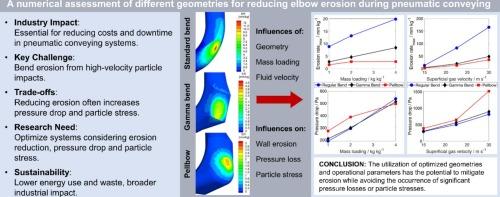A numerical assessment of different geometries for reducing elbow erosion during pneumatic conveying
IF 4.5
2区 工程技术
Q2 ENGINEERING, CHEMICAL
引用次数: 0
Abstract
This paper investigates wear characteristics in a dilute phase pneumatic conveying pipe system using a Euler-Lagrange method. Simulations couple computational fluid dynamics (CFD) with the discrete element method (DEM) to analyze three different bend geometries, including two erosion-reducing designs and a standard bend, all with an effective bend radius to pipe diameter ratio (R/D) of 1.5. SiO2 particles, 1 mm in diameter, are conveyed at gas velocities of 15 to 30 m/s and mass loadings of 1 to 4 kgparticle/kggas. The CFD-DEM predictions were validated against experimental data, showing good agreement in erosion distribution. The study evaluates erosion rates, pressure drops, and particle stressing for the three bends. Results suggest that certain bend designs significantly reduce erosion while slightly increasing pressure drop, although reduced particle-wall erosion may increase the overall particle stressing. The obtained results provide guidance on selecting an appropriate bend design and for potential geometry optimizations.

对减少气力输送过程中弯头侵蚀的不同几何形状进行数值评估
本文采用欧拉-拉格朗日法研究了稀相气力输送管道系统的磨损特性。模拟将计算流体动力学(CFD)与离散元素法(DEM)相结合,分析了三种不同的弯管几何形状,包括两种减少侵蚀的设计和一种标准弯管,所有弯管的有效半径与管道直径之比(R/D)均为 1.5。输送直径为 1 毫米的 SiO2 颗粒时,气体速度为 15 至 30 米/秒,质量负荷为 1 至 4 千克颗粒/千克气体。根据实验数据对 CFD-DEM 预测进行了验证,结果表明侵蚀分布情况良好。研究评估了三个弯管的侵蚀率、压降和颗粒应力。结果表明,某些弯管设计能显著减少侵蚀,同时略微增加压降,尽管减少颗粒壁侵蚀可能会增加整体颗粒应力。研究结果为选择合适的弯管设计和潜在的几何优化提供了指导。
本文章由计算机程序翻译,如有差异,请以英文原文为准。
求助全文
约1分钟内获得全文
求助全文
来源期刊

Powder Technology
工程技术-工程:化工
CiteScore
9.90
自引率
15.40%
发文量
1047
审稿时长
46 days
期刊介绍:
Powder Technology is an International Journal on the Science and Technology of Wet and Dry Particulate Systems. Powder Technology publishes papers on all aspects of the formation of particles and their characterisation and on the study of systems containing particulate solids. No limitation is imposed on the size of the particles, which may range from nanometre scale, as in pigments or aerosols, to that of mined or quarried materials. The following list of topics is not intended to be comprehensive, but rather to indicate typical subjects which fall within the scope of the journal's interests:
Formation and synthesis of particles by precipitation and other methods.
Modification of particles by agglomeration, coating, comminution and attrition.
Characterisation of the size, shape, surface area, pore structure and strength of particles and agglomerates (including the origins and effects of inter particle forces).
Packing, failure, flow and permeability of assemblies of particles.
Particle-particle interactions and suspension rheology.
Handling and processing operations such as slurry flow, fluidization, pneumatic conveying.
Interactions between particles and their environment, including delivery of particulate products to the body.
Applications of particle technology in production of pharmaceuticals, chemicals, foods, pigments, structural, and functional materials and in environmental and energy related matters.
For materials-oriented contributions we are looking for articles revealing the effect of particle/powder characteristics (size, morphology and composition, in that order) on material performance or functionality and, ideally, comparison to any industrial standard.
 求助内容:
求助内容: 应助结果提醒方式:
应助结果提醒方式:


